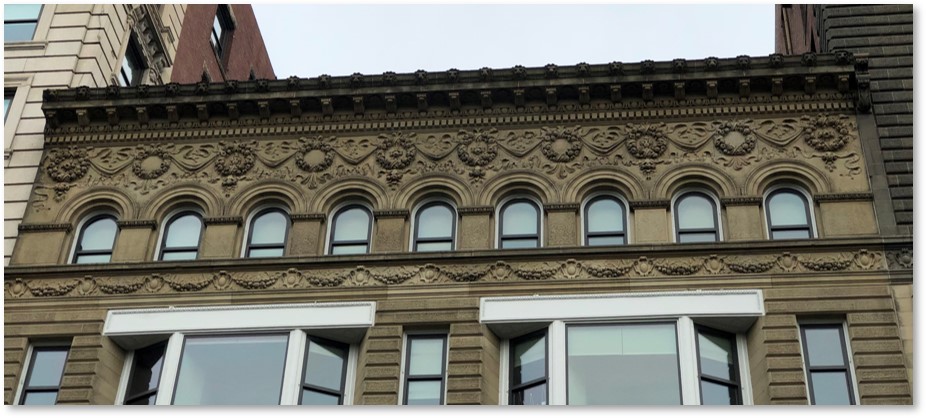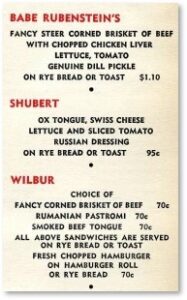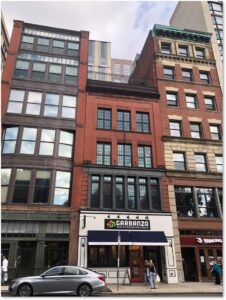Here is the second post in my short series on Boston’s Piano Row. One stretched into two and now I foresee three posts in this series. When digging into the past, one never knows what will come up. Joe Bagley, Boston’s official archaeologist and author of “A History of Boston in 50 Artifacts,” would probably agree.
Last week I ended with the Colonial Building. In today’s post, I begin my exploration of the buildings on Boylston Street’s Piano Row, with the building immediately to its left.
The Walker Building
#120 – #124 Boylston Street
1902
This 10-story structure was erected as a commercial office building. To be clear, only the west two bays go that high. The two bays on the east rise only six stories. The arched entrance is made of rusticated stone topped with an elaborately carved medallion. Brackets on either side hold up a balcony with a cast-iron railing and a medallion with a W for Walker at its center.
Atop the east section is a course of fruit garlands below nine recesses and arched window. Next, we see stone carvings of swags, fruit wreaths, and garlands. Above that is a dentil course, then brackets that hold up a cornice sporting multiple lion heads.
Offices and Shops
During Piano Row’s musical ascendency, the Walker Building housed the Pond Piano Company with the offices of the SS White Dental Manufacturing Company directly above it. The Mansfield School of Beauty opened in the Walker Building in 1909.
I could not find much information on the Walker Building architecturally, including who designed it, which is too bad. This is another one of Piano Row’s structures that gets no respect. Emerson College did restore the façade in 2019, though.
Steuben’s Restaurant
The Walker Building also housed Steuben’s Restaurant and Vienna Room, founded by two Austrian bothers, Max and Joe Schneider. This “restaurant, nightclub and hotspot” operated from the 1940s to the 1960s. Its five facilities included The Vienna Room, The Cave (Latin music) and The Blue Room (Big Band, Jazz and Swing groups). It serving meals and entertained both regular diners and after-theater crowds from the Colonial Theater next door and the Majestic Theater around the corner. Celebrities popped in after their shows to relax, often gravitating to the restaurant’s Café Midnight.
Steuben’s Restaurant claimed to be the “center of the Boston dining and nightlife scene.” It would have replaced The Cocoanut Grove after that nightclub’s destruction by fire in 1942. Steuben’s also hosted events and celebrations like proms and Sweet Sixteen parties. One look at the restaurant’s menu would have today’s diners calling it a Jewish deli but it was not kosher and served a variety of items later at night. In true deli fashion, however, sandwiches were named after local theaters.
Will & Grace in Residence on Piano Row
Today, Emerson College owns the Walker Building, which houses classrooms, study rooms, departmental offices, five computer labs, and the Iwasaki Library. One of the sets from the popular NBC sitcom, Will & Grace (1998-2006), donated by Emerson alumnus Max Mutchnik donated one of the sets from the popular NBC sitcom, Will & Grace (1998-2006). The set, which included Will and Grace’s living room and kitchen, was on display in the Iwasaki Library until 2013, when Emerson moved it to their Los Angeles campus.,
The fifth and sixth floors connect to the Tufte building. It can also be entered by a corridor at #25 Boylston Place.
Boylston Place
See the previous post on this alley-turned-pedestrian-walkway. Boylston Place: Education, Art and Football. When I wrote that post, I missed the Hi-Da-Way Restaurant, another dinner-and-dancing hotspot, truly hidden away at #3 Boylston Place. Henry J. Meagher owned the Hi-Da-Way, which served Jamaica Rum sherbet.
The Three Commercial Bricks
#130, #134, #140 Boylston Street
After Boylston Place we come to three narrow brick buildings with shops at street level and commercial or residential space above. They are six stories, four stories, and seven stories high respectively.
The first building, at #130, appears to be empty at the street level with people living above. The middle structure, at 134 Boylston Street, houses, Garbanzo, a Mediterranean restaurant. This one appears to have a partial cast-iron façade at the second level with four columns and two pilasters. Some Panel Brick work with window pediments decorates the next two floors. A carved-sandstone course of linked medallions appears just below the cornice.
The third building, at #14, houses The Shaking Crab, a Cajun seafood restaurant at street level. The first three floors are decorated with rusticated stonework. The next four stories are of brick with window cornices in stone that mirror the ones below. Brackets and a ledge separate the sixth and seventh floors where the windows are framed in stone. A copier cornice tops off the whole thing.
Although I was not able to source these buildings, they appear to be of a sameness with other 19th-century brick buildings in the neighborhood and around the city. If you have any information on their origins, please write a comment.
Ending at the 20th Century
We’ll stop there for today and pick up at Piano Row’s single 20th-century building to the west. Then on to Steinway and the Steinert Theater next week.





